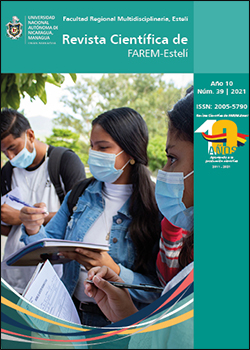Functional capacity of institutionalized older adults and the community, Nicaragua 2016
DOI:
https://doi.org/10.5377/farem.v10i39.12616Keywords:
Older adult, unctional capacities, fall risk, independence, dependence, health conditionAbstract
The objective of this study is to compare the functional capacities between two groups of older adults, those who inhabit a nursing home and those who live in the community. It is a cross-sectional, descriptive correlational, quantitative study, its unit of analysis are the older adults living together in different scenarios that were selected by convenience, being this a total of 28 adults (14 in each place). The techniques used were: interview, home visit, and direct and indirect observation. The instrument used was the clinical evaluation of the older adult. The SPSS 22 statistical software was used to process the data, which were analyzed by means of descriptive statistics of simple frequency, contingency tables, and Spearman’s Rho and Pearson tests with a significance of 5%. The main results show the predominance of the male sex in the nursing home with 57.1% and in the community the female with 71.4%, the age ranges for both were between 65 and more than 85 years, the greatest representation of origin in both was Managua, the levels of schooling were primary and secondary. In relation to health conditions, in both scenarios they presented more than two chronic diseases (89%), and have functional dependence in basic activities of daily living and instrumental activities (85%). Likewise, high and moderate levels of fall risks were found (42.84%). It is concluded that the two populations are significantly similar, both have limited functional capacities and some people reach the condition of disability.
Downloads
References
Acevedo Alemán, J. y. (2014). NO ENVEJECEMOS IGUAL: LA RELIGIOSIDAD Y EL GÉNERO EN ADULTOS MAYORES DEL NORESTE DE MÉXICO. Reflexiones, 133-144.
Alcaraz, E. A. (2014). Calidad de Vida de los Mayores que viven Institucionalizados en residencias para mayores. Un analisis cualitattivo. European Journal of investigation in Health, Phychology and Education , 225-234.
De La Fuente Sanz MM, M. I. (2012). La dependencia funcional del anciando institucionalizado valorada mediante el indice de Barthel. Gerokomos, 19-22.
FAMILIA, M. (2007). Conceptualizacion de Adultos Mayores de Nicaragua. Managua.
Guibert Reyes W, A. R. (2001). Factores epidemiológicos y psicosociales que inciden en los intentos suicidas. Revista Cubana de Medicina, 15-25.
INIDE. (2013). Estimaciones y Proyecciones de la Población Nacional. Managua.
Jorine Muiser, M. d. (2011). Sistema de salud de Nicaragua. Salud Pública de Mexico, 233--242.
Katz, S. D. (2010). Progress in the developement of the Indez of ADL . Gerentologist.
Mella R, G. L. (2014). Factores asociados al bienestar subjetivo en el adulto mayor. Psykhe, 79-89.
OPS/OMS. (2008). PROMOCIÓN DE LA SALUD Y ENVEJECIMIENTO ACTIVO. Washington, D.C. 20037.
OPS/OMS. (2012). Guía clínica para la atención del adulto mayor. Washington, D.C. 20037.
Paolo Garcia, L. V. (2004). Evaluacion Fisica y Funcional del adultos Mayores con deterioro Cognositivo. Med Risaralda.
Pedroso Crespo L, R. C. (2012). Envejecer, una problemática de salud, estudio biopsicosocial en el adulto mayor. Salud y vida.
PHAO. (2012). La salud de las Americas. Capitulo Nicaragua. Washington, D.C. .
Reisberg et al, D. a. (2013). Guia médica de atención integral del adulto mayor. Ministerio de salud Panama.
Rodríguez, I. (2013). Actividad física y envejecimiento poblacional. Repercusión en la calidad de vida. Revista Colombiana de Enfermería, 12-20.
Sáenz, M. d. (2011). Sistema de salud de Costa Rica. Salud Pública de México, 156-167. Obtenido de http://www.scielo.org.mx/scielo.php?script=sci_arttext&pid=S0036-36342011000800011&lng=en&tlng=.
Salinas C, J. e. (2011). ACTIVIDAD FÍSICA INTEGRAL CON ADULTOS MAYORES EN CHILE:RESULTADOS DE UN PROGRAMA PILOTO. REV.chil.nutr, 215-214.
Sequeira Calero, V. –C. (2000). Investigar es Fácil II. Managua.
Tinetti, M. (2006). PErformance - Oriented assessment of mobility problems in elderly patients. Journal of the American Geriatric Societyt, 119 - 126.
Zavala Gonzalez M.A, D.-S. G. (2013). Funcionalidad para la vida diaria en adultos mayores. Revista Medica del Instituto Mexicano de Seguridad Social, 585-590.
Published
Issue
Section
License
Copyright (c) 2021 Revista Científica de FAREM-Esteli

This work is licensed under a Creative Commons Attribution-NonCommercial-ShareAlike 4.0 International License.



